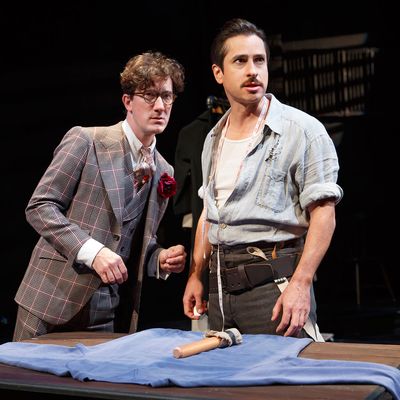
“Satire is what closes on Saturday night,” said George S. Kaufman, but that was 90 years ago. Today most satire closes — that is, shuts down internally — before it ever hits the stage. Have we lost the talent, or the taste? After seeing Nick Jones’s Important Hats of the Twentieth Century at Manhattan Theater Club’s Stage 2 space beneath City Center on Friday evening, I read the script on Saturday to see whether its failure to thrive was perhaps the result of the amateurish production, directed by Moritz von Stuelpnagel. It wasn’t, though the unaccountably loud acting and tedious pinball staging certainly didn’t help matters. The problem — as was also the case with Jones’s Verité, seen earlier this year at LCT3, and The Coward, from 2010 — is inherent in the concept, or lack of one. No one involved seems to have operated from the understanding that satire is a pinpoint form of criticism, not a clown car in which irrational characters with funny lines get taken for a ludicrous spin.
And ludicrous Important Hats is, even more so than those earlier outings. Set primarily in 1937, it concerns the rivalry between two clothing designers: Sam Greevy, a dandy who dresses women in flamboyant outfits adorned with “little ball things,” and Paul Roms, a onetime janitor who is stealing Greevy’s thunder with his unisex, utilitarian styles. But what at first seems likely to be a spoof of fashion is hijacked by a spoof of science fiction when it transpires that Roms’s innovations — including sweatpants and tracksuits and butt-revealing low-rise jeans — are not just futuristic but stolen from the future. A time-travel hat created by the “brilliant overweight scientist” Dr. Cromwell allows Roms to visit the bedroom of a 1989 teenager, abscond with his hideous slacker-wear, copy it upon his return to 1937, and sell it as the latest thing. I hoped at this point we might get back on track with the fashion satire, but no, Jones now turns his attention to the causal paradox that results from Roms’s tearing of the space-time fabric. Giant menacing orbs appear over New York, apparently sent by the cosmos to repair the rip; now we’re slogging through a screwball take on War of the Worlds. Need I go on? Unfortunately, Jones does.
Much of this, I hasten to add, might actually be funny in smaller doses. Jones (who, like all midcareer playwrights, writes for Orange Is the New Black) has a fantastic ear for absurdities. One of Dr. Cromwell’s previous inventions was a “serum that made cats less selfish.” Roms’s low-rise jeans “are beautiful for dramatizing the struggle of remaining clothed.” And at certain points, a farcical, comic-book energy starts to take hold, as when the time-travel hat malfunctions. (Among other things, this leads to a scene involving masturbating sasquatches.) But by then the satirical focus is so diffused that the audience is in too much of a blur to care. It’s impossible to say what the play wants us to laugh at — silly clothes, non-silly clothes, dim cops, venal newspapermen, petulant teenagers, vainglorious scientists — let alone what, if anything, it wants us to think.
This confusion isn’t just the result of the chaotic plotting, though Jones’s idea of tying up loose ends resembles what would happen if a cat did macramé. The confusion is also built into the mismatch between genre and character. It’s asking too much that contemporary playwrights succeed in satire at the level of Oscar Wilde, but one reason none do is that they fail to observe the master’s technique. Wilde understood that only one element of a comedy can be wild at a time. If the plot is absurd, the characters must be rational and the follow-through utterly disciplined; otherwise you end up satirizing grotesque individuals instead of a deranged society. Jones’s characters are so inconsistent, so idiotic and over-the-top, that however momentarily amusing they may be (I grudge-laughed a lot) they totally overpower the play’s ability to operate within its genre. One might argue that this scattershot spray of satirical fire is more aptly modern; clearly Jones aspires to the Pynchonesque by way of Saturday Night Live. But however well hysteria may work in prose and in short sketches — not very well in my opinion — it isn’t funny, or even followable, onstage.
This problem is not minimized by the performances. As Greevy, Carson Elrod is styled as a dead ringer for the costumer William Ivey Long; he then turns up the dial to maximum on the screamy, queeny, flibbertigibbet mannerisms. To say that Matthew Saldivar is a touch subtler as the Neanderthal Roms is to compare blender settings of whip and shred. And while there are nice turns in smaller moments from the rest of the nine-person cast, among the leads only John Behlmann, as the noir-style, lantern-jawed fashion reporter who is also Greevy’s lover, is able to maintain a consistent and legible tone throughout the extended skit-like proceedings. Wait, I am too hasty. Those self-pleasuring sasquatches are faultless, doing only what the play tries to do, but better.
Important Hats of the Twentieth Century is at City Center Stage 2 through January 3.




